For a long time, I avoided aftermarket shifters for the ZF six-speed because I thought they were either just for drag racing or couldn’t make a useful contribution to aggressive street driving, autocrossing or road racing. Well, after noting there are now three different aftermarket gear shift enhancements for the ZF and, figuring there wouldn’t be that many choices if the products weren’t of some benefit; I decided to try one made by the greatest name in shifters, Hurst, in my ’95 Coupe.
Boy…were my preconceived ideas proven wrong!

The Fairest Sandra the Red at the wheel of my ’95. Even she noticed the Hurst’s enhanced shift feel. Both of us are converts. Image: Author.
The ZF S6-40, six-speed, manual transmission, a joint development of ZF Friedrichshafen AG in Germany and GM Powertrain in the United States, was used in Corvettes from model year (MY) 1989 to 1996. From a shift mechanism perspective, compared to the Warner, Muncie and Nash four-speed manuals used from MY57-88, the ZF represented a quantum leap in technology. The three previous designs used an external linkage (a monkey-motion affair of rods, clevises, pins, plastic bushings and clips) on the side of the transmission to transmit the driver’s movement of the gear shifter to levers on the side of the transmission. Those levers were bolted to shafts that went through the transmission case. Inside the transmission, on the end of each shaft, was another lever and, on the end of that, was the shift fork that moved a dog clutch assembly to accomplish the gear change.
The ZF’s introduction for MY89 marked the first time a Corvette had a transmission with an internal rail shift mechanism. The entire external linkage, two of three shafts going through the transmission case and all levers outside and inside the gearbox were eliminated. It was all replaced by a short “shift rod”, with universal joints at each end. That “linkage” connects the shift lever to the S6-40’s gear shift shaft which runs through the rear of the transmission case and engages one of three sliding rails inside the transmission. The shift forks are affixed, solidly, to those shift rails. By rotating, the shift shaft selects the proper rail and, by sliding, it selects one of two gears serviced by that rail. This design vastly simplified the system, reduced shift effort, enhanced shift feel, decreased noise and increased reliability and durability. Anyone who took back-to-back drives in a 1988 with the Doug Nash “4+3,” then an ’89 with the ZF six-speed was amazed at the improvement.
As good as it was, the new six-speed’s shift mechanism had compromises made in the interest of appealing to a very wide range of Corvette owners. In the opinion of some aggressive drivers, these compromises were: excessive shift throw length, a shift knob height that was too high and imprecise shift feel. The new Hurst Billet/Plus Competition Shifter for ZF six-speeds is the only aftermarket shifter that properly addresses all those complaints.
The Hurst Billet/Plus is the brainchild of engineer/Corvette enthusiast, Chris Rinehart. He disliked the stock ZF shifter’s long throw and its imprecise feel enough to design and build his own gear shifter. After driving his ZR-1 a while with the new shifter, he knew he’d hit upon a potentially successful product but he lacked resources to develop it for mass production or market it. Rinehart made a deal with Hurst for volume production and Hurst brought his shifter to market as the Billet/Plus in 2001. Rinehart continues to work with Hurst as a engineering and development consultant on Corvette products.
The Hurst is not the first product of its type. Prior to its introduction, B&M Racing and Performance Products had marketed it its “Ripper” shifter for several years and White Racing Products had been selling its “Short Shifter” modification kit for the stock shifter. Both these products are popular with drag racers, however, while both make a positive contribution to shortening shift throw; they do not, in this writer’s opinion, address all the requirements of a good aftermarket shifter for a ZF S6-40.
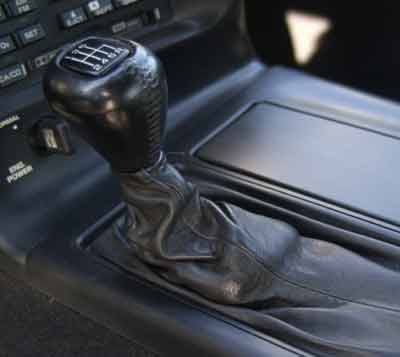
One nice thing about the Hurst Shifter for C4s with ZFs is, other than a small decrease in shift lever height, it looks stock. Image: Author.
How about some numbers? The stock shift throw is approximately 5.5-in., fore-aft, and, cross-car, it’s about 1.5-in. gate-to-gate. The B&M shortens these distances by a whopping 60%. The WRP kit reduces them 45% and the Hurst reduces them by 30%. The huge reduction from the B&M shifter and the significant reduction from the White Racing kit might seem exactly what the sporting driver wants, but there is a downside of those large reductions: a corresponding increase in shift effort.
The B&M Ripper causes the ZF’s shift effort to skyrocket by a factor of 2.5. While drag racers usually don’t have a problem with that, it makes a B&M-equipped ZF hard to shift for the casual user or even those racers who don’t use brute strength in gear shifting. The B&M also can make it hard to select first or reverse when the car is stopped. This difficulty sometimes forces one to take a partial “stroke” of the clutch pedal to change the position of the dog clutches to get the car in gear. Another problem with the B&M? In my opinion, its shift throw reduction is, actually, too much. The resulting square shift pattern sometimes makes for confusion in shifting. If a driver is confused in shifting and hesitates during the shift because of it, then the value of a short-throw shifter is negated.
The White Racing Products Short Shifter kit, while modifying the stock shifter for a shorter throw and not causing such a problem with shift effort, has its own set of limitations. It requires a permanent modification of the ZF’s tail housing. Because the kit moves the stock gear shift rod’s rear cross pin (a tiny u-joint where the fore-aft and cross-car motions of the shifter are changed to the fore-aft and rotating motion of the shift rail) down nearly an inch, the cross pin’s movement interferes with one of the housing’s reinforcing gussets, so that part of the tail housing structure must be removed. Whether or not this weakens the tail housing enough to affect durability is unknown, but it is possible that it may. Another problem with the WRP Kit is that, because it accomplishes its entire throw reduction by moving the cross-pin lower, the angle between the shift lever and the shift rod ends up being less-than-optimum causing the system to partially bind. The result is increased effort on top of what is gained with the throw reduction.
The O.E. shift lever is actually two pieces joined, just below the shift boot, with a soft rubber coupling. This coupling exists to damp noise and vibration but also reduces the feeling of precision that many Corvetters desire. A third drawback of the WRP kit is that, since it modifies the stock shift lever but retains the coupling, there is little improvement in shift feel.
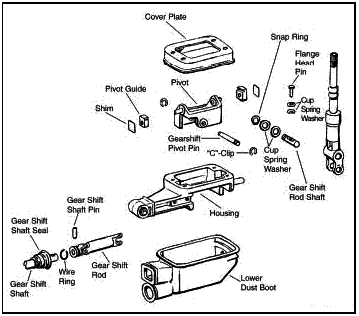
This exploded view details the ZF shifter. The B&M replaces both the “pivot” and the shift lever. The WRP Kit, adds an extension to the bottom of the shift lever. The Hurst replaces the lever. Image: Hurst/Mr. Gasket.
The Hurst Billet/Plus Shifter gives you all the advantages–shorter throw and improved shift feel–of an aftermarket shifter, but none of the drawbacks–excessive effort, confusion in shifting, linkage binding or permanent modification of the transmission. The Hurst gets its throw reduction from the combination of a 1.25-in. decrease in shift lever height and a .236-in. lowering of the rear cross-pin. This somewhat conservative design keeps shift effort at an acceptable, 1.4-times stock, puts fore-aft throw at about four-inches (nearly twice that of the B&M) and has cross-car throw at a little over one-inch. The Hurst reduces shift throw just the right amount such that the pattern doesn’t become overly small and effort doesn’t get too high.
Experiences: With Hurst installation complete, I bid Automasters farewell and made the 125-mile run back home. That and another 250-mile trip a week later, gave me a pretty good initial road test of the shifter. There was no question in my mind that the Hurst’s roughly 30% decrease in throw is just right. The increase in effort that comes with that is acceptable compared to marginally high effort from a WRP-modified stock shifter and the B&M Ripper’s unacceptable effort. With the Hurst, I never had a problem feeling which gear I was in and there are no troubles shifting into gear with the car stopped.
In seven years of driving my ZR-1, my timing of clutch and shifter movement during the fast shifts necessary in autocross or road race driving is well developed and often practiced. With the Hurst installed, I now shift the transmission faster so, during track driving, I’ll need to get used to working the clutch faster. That I have to “relearn” my shifting coordination, means my new shifter really works. While I like the newfound speed in shifting, my favorite feature of the Hurst Shifter is the improvement in shift feel. I love the higher level of precision and feedback I feel from the transmission along with that purposeful,subdued “clack-clack” I hear from the ZF as I shift gears.
Bottom line: the Hurst Billet/Plus Competition Shifter works very well. It’s an outstanding choice for an aftermarket shifter. It offers an excellent balance between throw, effort and precision that is unmatched by any other aftermarket gear shift product for six-speed C4s.
Installation: I took my ’95 ZR-1 to Automasters in Palm Desert, California for the Hurst shifter installation. Automasters is a service and tuning shop specializing in C4s and C5s, operated by Corvette enthusiast and road racer Jim Van Dorn. The first time I went to Automasters was back in 1997 when I had them give my LT5 engine the “Street Skinner” engine performance enhancement package. That raised its horsepower from 405 to 490. I went with Automasters for the shifter work because: 1) their technicians could get the job done quicker on a lift than I could do it lying on my back in my garage and 2) Van Dorn and his Lead Technician Joe Delara are longtime C4 Corvette experts who work on my car the way I’d do it myself.
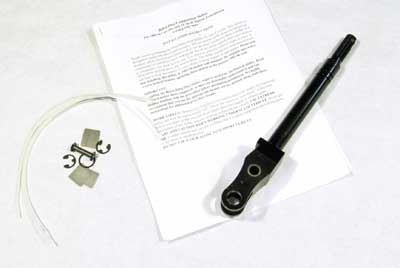
The Hurst package is pretty simple: a replacement shift lever, shims for setting the end-play, cable ties for the lower shift boot and instructions. Image: Author.
For those working on their own cars, the Hurst people include a very good set of instructions with the Billet/Plus Shifter. The job takes DIYs with intermediate mechanical skills and common hand tools, a floor jack and jack stands about three hours.
A professional, working with the car on a lift, can get the shifter done in two hours or less. In brief, the sequence of events was: Joe Delara removed the center console trim and shift boots such that the gear shift mechanism was exposed, then he cut the retaining straps holding the ZF’s lower shifter boot. He raised the car and removed the exhaust system. He pulled the lower boot aside then disassembled the rear cross pin. He lowered the car, removed some fasteners and removed the O.E. shifter from the top.
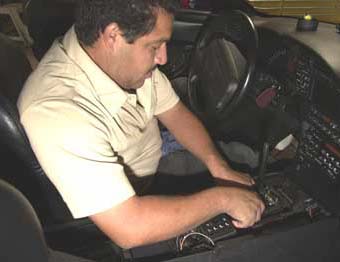
First step is to remove the console top trim. This also requires removal of the console box door. Image: Author.
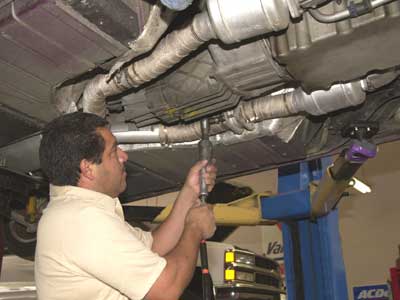
The exhaust system must be removed. Image: Author.
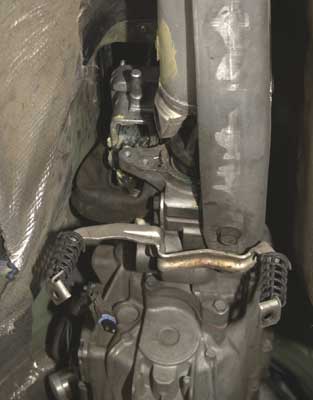
Once the exhaust is off, the lower boot rolled back and the VSS connector removed, this is what you see. You’re ready to disconnect the stock lever. Image: Author.
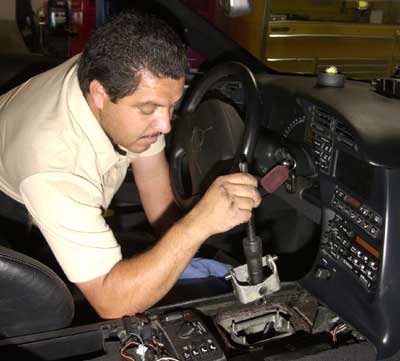
The old shifter comes out from the top. Image: Author.
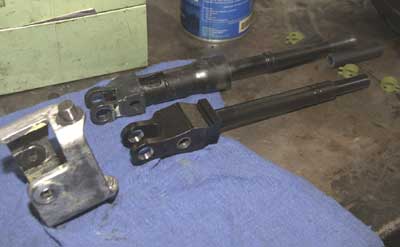
Top is the O.E. shifter. It’s a two-piece unit with the upper and lower sections joined with a rubber coupling inside the area near the top of the larger-diameter, lower section. The Hurst ditches the rubber coupling, has a shorter lever but a longer distance between the lever pivot point and the shift rod connection. Those different dimensions is what shortens the throw. The silver part at left is the stock cardian joint or pivot. The Hurst retains that part. Image: Author.
He reinstalled the shifter assembly onto the transmission through the center console opening. He raised the car, then lubricated and installed the new Hurst cross pin. He reinstalled the exhaust then, with the car back on the ground, finished the job by replacing the shift boots, console trim and the shift knob.
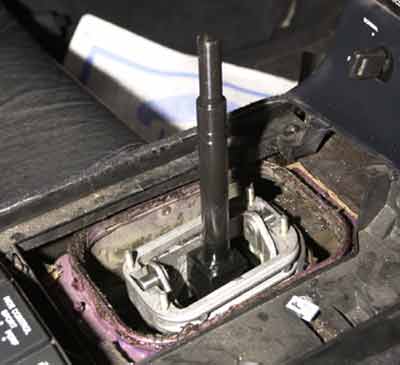
The Hurst installed in the pivot but before the shims are reinstalled. Image: Author.
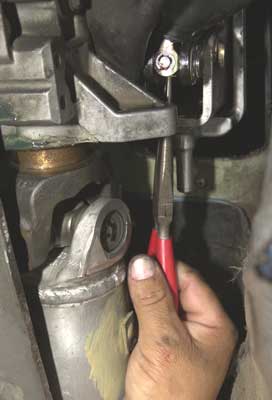
Getting the cross pin’s upper retainer in place is a bit of a challenge. A set of very long nose pliers is the trick tool to use for this. Image: Author.
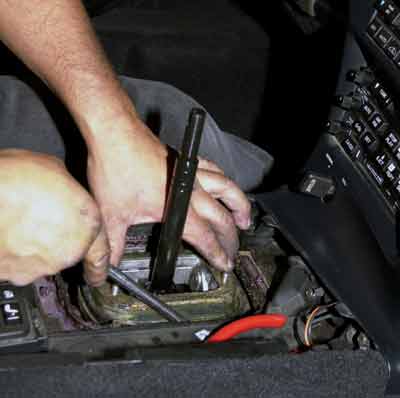
The lower boot is folded back in place from the bottom but the outer lip of the boot must be properly installed around the shifter mounting from the top and using a large, flat-blade screw driver. Image: Author.
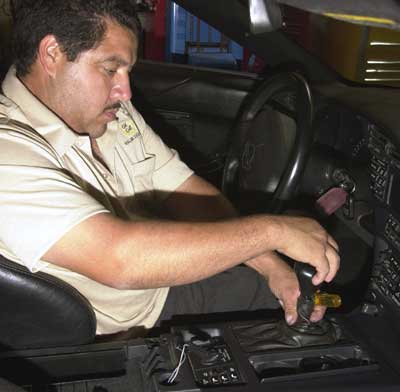
Joe Delara’s final touch was to reinstall the shift knob. Image: Author.
After the quick but careful Hurst Shifter installation, it was only fair to let Joe take the first test drive. Sometimes my buddy, Mr. Delara, is a bit of a skeptic when it comes to hot rod stuff but he came back from a 10-minute test drive with a smile on his face and said that the Hurst Shifter reduced shift throw just the right amount and that he liked the improved shift feel.
Comments: For more information on the Hurst Shifter for ’89-’96 manual-transmission Corvettes, contact Hurst / Mr. Gasket Company, 10601 Memphis Ave. #12, Cleveland, OH 44144.
Tel: 216.688.8300. Web: www.mrgasket.com. Email Chris Rinehart: gt1479b@prism.gatech.edu

![[Product Review] Hurst Billet/Plus Competition Shifter for C4 Corvette [Product Review] Hurst Billet/Plus Competition Shifter for C4 Corvette](https://www.corvetteactioncenter.com/wp-content/uploads/2021/02/hurst-billet-plus-shifter-c4-corvette-1170x878.jpg)